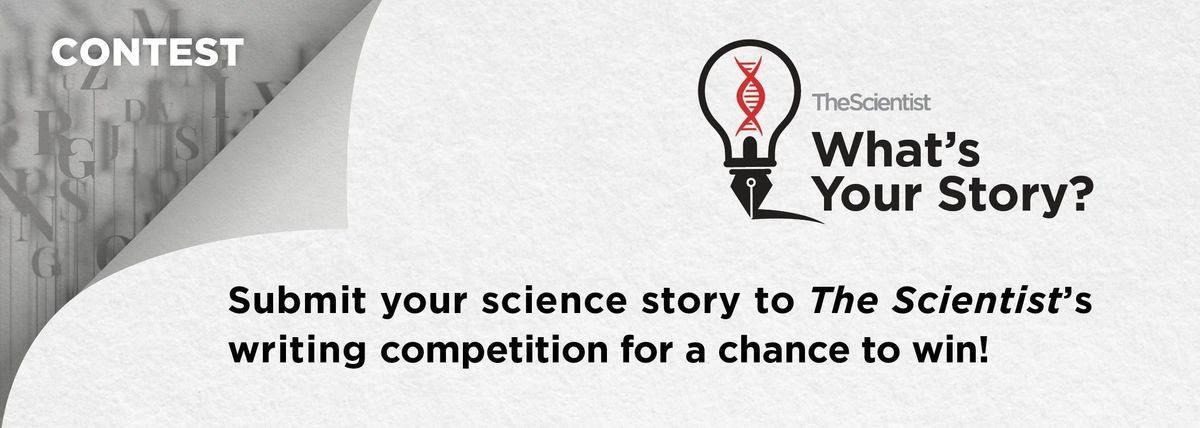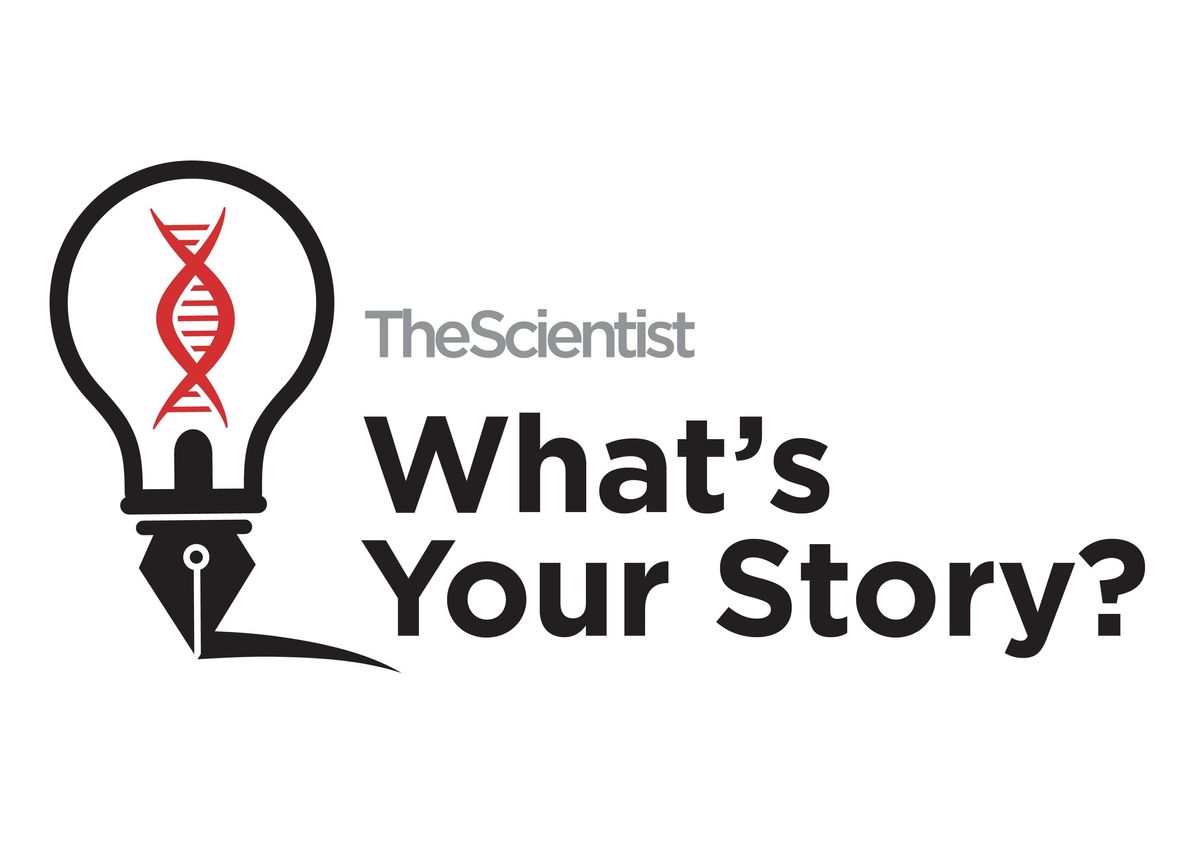
What’s Your Story?
The Scientist’s writing competition provides senior scientists, graduate students, research associates, and lab managers the opportunity to tell science stories and sharpen their science communication skills. Entries will be judged by The Scientist’s PhD-trained science communicators, and winners will receive wide exposure through The Scientist’s online platforms.
The Audience
Our readers are mainly researchers working in or supervising a lab who are fascinated by science and ready to read most topics if presented correctly. They are used to wading through dense research paper content, but do not expect to exert this level of effort for news. They read this for fun in their down time.
The Story
When structuring your story, keep the reader in mind. Imagine researchers reading your story on their phones on the train after work. As scientists, they expect accuracy and for important details to be included, but if they are interested in the full study, they will go to the original paper. One of the most important and difficult tasks in science journalism is to find the right amount of detail to include: too much and readers won’t wade through it with only casual curiosity motivating them, but not enough will give them little in return for their effort in reading the story, or even worse, confuse them.
A good story will teach them a lot with very little effort. If the story pertains to their area of research, the writer has provided a good summary to let them know whether the paper is worth working through. If not, they have broadened their understanding of biology and maybe found a good conversation starter.
Stories should be submitted in MS Word documents and include the following:
- Title
- 1-2 sentence teaser text
- Byline
- 500-600 words text including quotes from primary and secondary sources (use “said” not “says”)
- References in AMA style
- Image (a previously unpublished image from a researcher or an uncopyrighted stock image e.g. iStock, Creative Commons, etc.)
- Image link
- Image caption in complete sentences
- Image credit
- Screen shot of the email giving permission to use the image on The Scientist website
The Interview
Gather information beyond what is in the paper to add interest and context. Readers are interested in the human side of the story—the experiences, thoughts, feelings, and motives of the people involved. What led them to this point? How do they feel after achieving this goal? What will they do next?
Read between the lines when reviewing the paper to identify areas that might be particularly interesting. For example, is there a large discussion of troubleshooting a particular experiment? If so, comments on how hard it was to get that experiment working and what finally resolved the problem can add a lot of color to the story. Or maybe you notice a discussion section that is more speculative than usual, indicating that the authors have lofty goals for this line of work. These observations often lead you directly to what most interests the authors and where they are more likely to give exciting quotes.
Interviews are also great for eliciting comments from the authors that you would not say in your own voice, such as, “This definitively proves that prior study wrong,” or “This is the first step towards curing all types of asthma.” That said, it is very important that you do not rely too heavily on quotes. You are the writer, and the majority of the story must be presented in your words and voice.
To get good quotes, prepare questions before the interview, but keep in mind that many of the best quotes come from follow up questions during the call. Listen closely and be ready to redirect the conversation to follow up on interesting comments and to draw out the researcher’s thoughts and ideas about the study as well as his or her personal experiences working on it.
There are many excellent questions to start these conversations, and the questions will vary from paper to paper and researcher to researcher. Here are a few examples:
- How did you first become interested in…?
- What motivated you to perform this study?
- What was the biggest challenge in getting … to work?
- How did you overcome that challenge?
- How did you feel when you saw the result?
- What was your reaction to…?
- What impact will this study have on your field?
- What are your next steps?
- What are your long-term goals for this line of research?
Researchers can also provide context for the paper, letting you know what other studies led to this advance and where it fits with related work. If you ask, they may alert you to controversies in the field or ideas that have been overturned by the recent work. These elements are interesting to readers too.
The Good Story
Interesting stories include those where the topic is of general interest and readers are drawn in by curiosity elicited by the title and teaser text. The stories that appeal most to The Scientist‘s readers include the following:
- Big questions: topics address fundamental ideas that interest all biologists
- Quirky: stories that are uncommon or unique in some way
- Daily life: readers relate to the topics
- Timely: up to date news, stories that relate to holidays, or other topics presently on readers' mind
- Unexpected, surprising, or fascinating: something interesting enough to stop what you're doing to read, and something that creates a desire to tell others what you read
- Controversial: who doesn't love a good controversy?
Browse story examples here.
The Story Breakdown
[Title] How the Venus Flytrap Captures Its Prey
[Teaser] Scientists used CRISPR-Cas9 for the first time in a carnivorous plant to prove the role of two ion channels in closing the Venus flytrap’s trap.
[Hook: Relate to the reader or catch attention]
[Intro and context] An insect lands on the open leaves of a Venus flytrap plant, drawn to an appealing scent. It noses around and accidentally brushes one of the trap’s trigger hairs. An action potential shoots across the leaf blade. The insect keeps moving and bends another trigger hair, propagating a second action potential; suddenly, the leaves snap shut, trapping the insect, enveloping it in digestive juices, and absorbing the bug’s rich nutrients.
How these two light touches trigger abrupt shutting of the leaves has been hypothesized, but never proven. [Nut graph] Now, in a new study published in Current Biology, a team of researchers knocked out two ion channels, making it harder to produce action potentials and proving the channels’ importance in leaf closing.1
[Lead quote] “The paper is a very big technical advance,” said plant biophysicist Rainer Hedrich at the University of Wurzburg who was not involved in the study. “It is possible to knock out genes in an excitable plant and test hypotheses.”
[Brief background]
Carnivorous plants and their quick movements have fascinated scientists for centuries. In the 1870s, Darwin and his colleagues discussed how electrical currents played a role in leaf closing.2,3,4 More recently, scientists found mechanosensitive ion channels FLYCATCHER1 (FLYC1) and FLYCATCHER2 (FLYC2) expressed in trigger hairs that may associate with touch sensitivity.5 Even though the Venus flytrap’s genome is sequenced, no targeted mutations of ion channel genes have been made to conclusively prove their roles in leaf closing.
[Introduce the study and authors]
So, plant biologists Carl Procko and Joanne Chory at the Salk Institute decided to use CRISPR-Cas9 to mutate FLYC1 and FLYC2 to investigate their functions. Scientists had hypothesized that an insect’s touch causes deformation of the trigger hair’s sensory cell membrane, which causes the opening of these ion channels and membrane depolarization and electrical signaling.
[What did they do?]
Procko grew Venus flytrap plants in tissue culture and then fired gold particles covered with plasmid DNA containing components of the CRISPR-Cas9 system into the cells. In the plasmid, the researchers also included a gene for a fluorescent protein to identify the plasmid-bearing tissue. The team propagated the genetically transformed cells and eventually grew a new plant. The plant was mosaic; it carried the plasmid DNA in some leaf arms, while others were wild type.
Procko chose leaflets that were fully transgenic (and fluorescent) and clonally separated them in tissue culture. To determine whether the leaves were single or double mutants, Procko used PCR-based Sanger sequencing and genotyping. He chose single mutants for some experiments and double mutants for others. He then planted the plants in soil and continued to grow them in a greenhouse.
Next, he triggered the double mutant plants with a touch from thin, fire-polished glass rod mounted on a micromanipulator; they closed just as often and as quickly as the wild type plants. “You get a plant that looks normal,” said Procko. [Human side of research] “You sit there, and you scratch your head a bit.” Procko thought that perhaps the defect was smaller than could be detected using the relatively large touch of a pipette and decided to search for another more subtle quantitative assay.
He collaborated with molecular neurobiologist Sreekanth Chalasani, also at the Salk Institute, who works with ultrasound. When the team tested the plants with a new, more sensitive assay using ultrasound waves to stimulate the trigger hair, the FLYC1-FLYC2 double mutants showed a significant defect: mutated plants required a greater ultrasound pressure to induce the trap closure than wild type plants. The team noted that single FLYC1 mutants stimulated with ultrasound closed just as well as the wild type plants. Procko believes that brute force mechanical stimulation with the glass rod may be so large that it could act through different mechanosensitive ion channels in the trigger hair.
[Where will this study lead?]
“The next step now is to start looking at these other mechanosensitive channels that are within the trigger hair,” said Procko. “We can start to mutate some of these others and put them in various combinations to see exactly which mechanosensitive channels are most important or if they’re all required together to get that very exquisite touch sensitivity of the trigger hair.” Hedrich’s team is currently working to knock out a calcium channel gene hyperosmolality-gated calcium-permeable channel (OSCA).
Procko acknowledged that he didn’t know exactly how the ultrasound assay relates to touch, which limits the study. “It’s a mechanical stimulus. We like to think it’s related to touch, but it could alternatively be applying that stimulus directly to the sensory membranes and altering the membranes. So, this is still a little bit of a question mark,” said Procko.
- Procko C, et al. Mutational analysis of mechanosensitive ion channels in the carnivorous Venus flytrap plant. Curr Biol. 2023;33:3257-64.
- Darwin, C. Insectivorous Plants. 1875.
- Burdon-Sanderson, JS. Note on the electrical phenomena which accompany irritation of the leaf of Dionaea muscipula. Proc. R. Soc. Lond. 1873;21:139-147.
- Williams, SE. A salute to Sir John Burdon-Sanderson and Mr. Charles Darwin on the Centennial of the Discovery of Nerve-Like Activity in the Venus’ Flytrap. CPN. 1973; Vol. II(3) 41-43.
- Procko C, et al. Stretch-activated ion channels identified in the touch-sensitive structures of carnivorous Droseraceae plants. eLife. 2021;10:e64260.
